Criminology Assignment 3: Analysis of Crime and Violence in Society
VerifiedAdded on 2022/09/28
|7
|1952
|25
Homework Assignment
AI Summary
This criminology assignment addresses several key aspects of criminal behavior and societal violence. Part A examines serial killers through a sociological lens, highlighting the advantages of this approach in understanding their motives and behaviors, and also discusses the reasons why individuals stay in abusive relationships. Part B delves into the common factors and legal frameworks surrounding domestic violence, differentiating it from other forms of crime while also discussing relevant legislation. Part C focuses on the risk factors contributing to violent crimes against Aboriginal women in Canada, referencing specific cases and official reports to analyze the issue. The assignment emphasizes the importance of viewing these crimes as serious offenses, rather than solely as sociological phenomena. The assignment provides a detailed analysis using sociological perspectives and real-world examples to explore these complex issues.

1Running head: CRIMINOLOGY
Criminology
Author’s Name
Institutional Affiliation
Author’s Note
Criminology
Author’s Name
Institutional Affiliation
Author’s Note
Paraphrase This Document
Need a fresh take? Get an instant paraphrase of this document with our AI Paraphraser
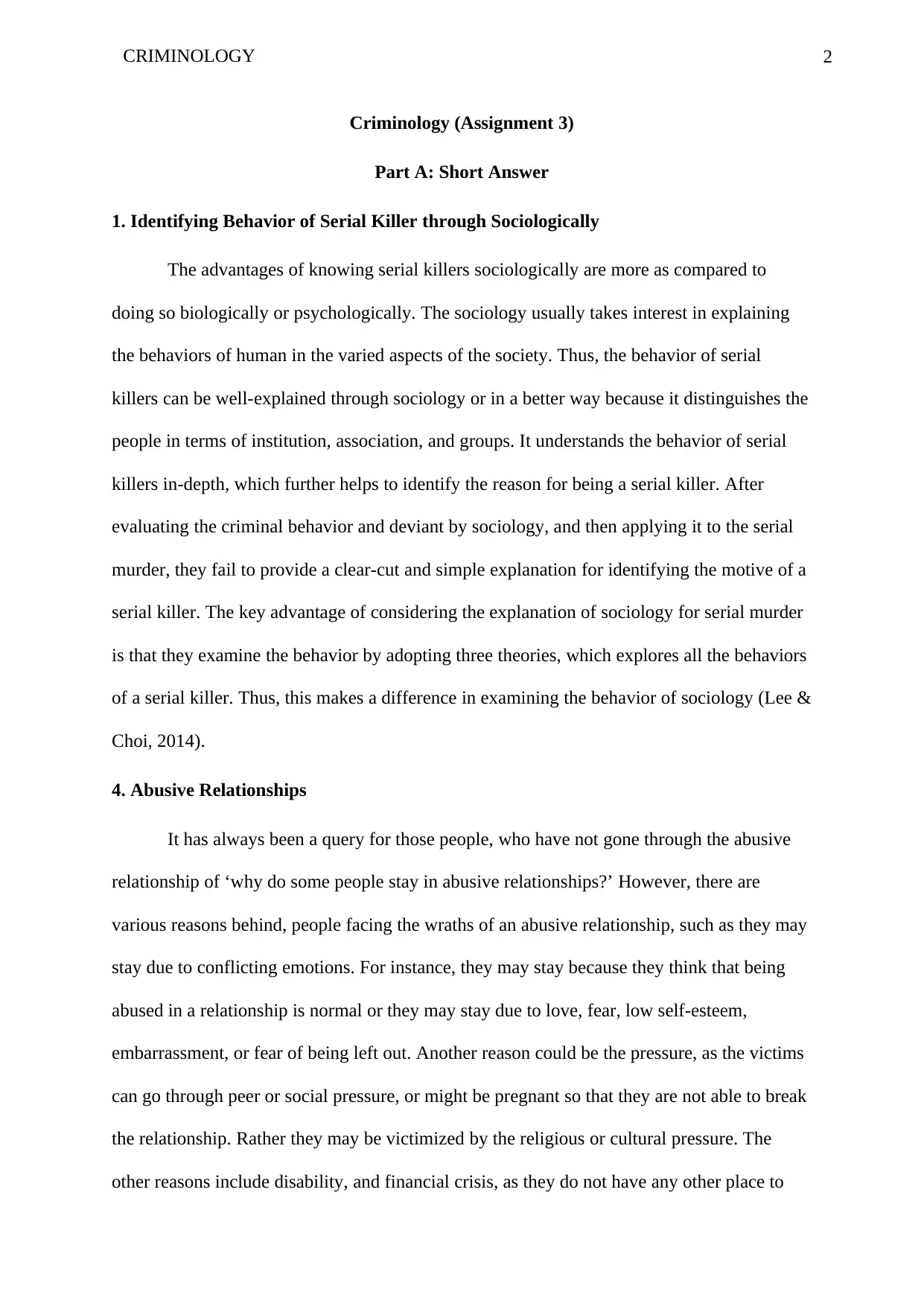
2CRIMINOLOGY
Criminology (Assignment 3)
Part A: Short Answer
1. Identifying Behavior of Serial Killer through Sociologically
The advantages of knowing serial killers sociologically are more as compared to
doing so biologically or psychologically. The sociology usually takes interest in explaining
the behaviors of human in the varied aspects of the society. Thus, the behavior of serial
killers can be well-explained through sociology or in a better way because it distinguishes the
people in terms of institution, association, and groups. It understands the behavior of serial
killers in-depth, which further helps to identify the reason for being a serial killer. After
evaluating the criminal behavior and deviant by sociology, and then applying it to the serial
murder, they fail to provide a clear-cut and simple explanation for identifying the motive of a
serial killer. The key advantage of considering the explanation of sociology for serial murder
is that they examine the behavior by adopting three theories, which explores all the behaviors
of a serial killer. Thus, this makes a difference in examining the behavior of sociology (Lee &
Choi, 2014).
4. Abusive Relationships
It has always been a query for those people, who have not gone through the abusive
relationship of ‘why do some people stay in abusive relationships?’ However, there are
various reasons behind, people facing the wraths of an abusive relationship, such as they may
stay due to conflicting emotions. For instance, they may stay because they think that being
abused in a relationship is normal or they may stay due to love, fear, low self-esteem,
embarrassment, or fear of being left out. Another reason could be the pressure, as the victims
can go through peer or social pressure, or might be pregnant so that they are not able to break
the relationship. Rather they may be victimized by the religious or cultural pressure. The
other reasons include disability, and financial crisis, as they do not have any other place to
Criminology (Assignment 3)
Part A: Short Answer
1. Identifying Behavior of Serial Killer through Sociologically
The advantages of knowing serial killers sociologically are more as compared to
doing so biologically or psychologically. The sociology usually takes interest in explaining
the behaviors of human in the varied aspects of the society. Thus, the behavior of serial
killers can be well-explained through sociology or in a better way because it distinguishes the
people in terms of institution, association, and groups. It understands the behavior of serial
killers in-depth, which further helps to identify the reason for being a serial killer. After
evaluating the criminal behavior and deviant by sociology, and then applying it to the serial
murder, they fail to provide a clear-cut and simple explanation for identifying the motive of a
serial killer. The key advantage of considering the explanation of sociology for serial murder
is that they examine the behavior by adopting three theories, which explores all the behaviors
of a serial killer. Thus, this makes a difference in examining the behavior of sociology (Lee &
Choi, 2014).
4. Abusive Relationships
It has always been a query for those people, who have not gone through the abusive
relationship of ‘why do some people stay in abusive relationships?’ However, there are
various reasons behind, people facing the wraths of an abusive relationship, such as they may
stay due to conflicting emotions. For instance, they may stay because they think that being
abused in a relationship is normal or they may stay due to love, fear, low self-esteem,
embarrassment, or fear of being left out. Another reason could be the pressure, as the victims
can go through peer or social pressure, or might be pregnant so that they are not able to break
the relationship. Rather they may be victimized by the religious or cultural pressure. The
other reasons include disability, and financial crisis, as they do not have any other place to
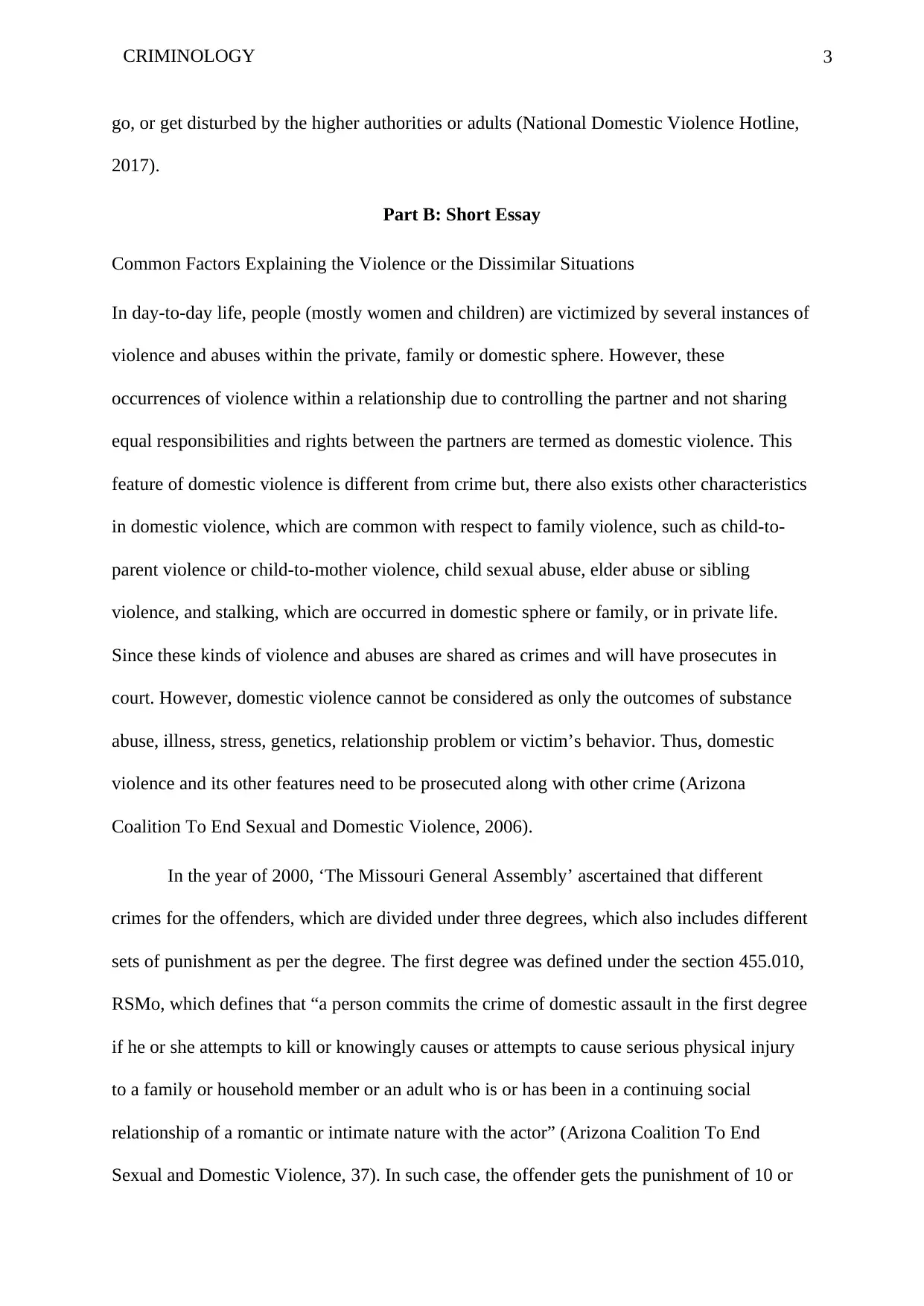
3CRIMINOLOGY
go, or get disturbed by the higher authorities or adults (National Domestic Violence Hotline,
2017).
Part B: Short Essay
Common Factors Explaining the Violence or the Dissimilar Situations
In day-to-day life, people (mostly women and children) are victimized by several instances of
violence and abuses within the private, family or domestic sphere. However, these
occurrences of violence within a relationship due to controlling the partner and not sharing
equal responsibilities and rights between the partners are termed as domestic violence. This
feature of domestic violence is different from crime but, there also exists other characteristics
in domestic violence, which are common with respect to family violence, such as child-to-
parent violence or child-to-mother violence, child sexual abuse, elder abuse or sibling
violence, and stalking, which are occurred in domestic sphere or family, or in private life.
Since these kinds of violence and abuses are shared as crimes and will have prosecutes in
court. However, domestic violence cannot be considered as only the outcomes of substance
abuse, illness, stress, genetics, relationship problem or victim’s behavior. Thus, domestic
violence and its other features need to be prosecuted along with other crime (Arizona
Coalition To End Sexual and Domestic Violence, 2006).
In the year of 2000, ‘The Missouri General Assembly’ ascertained that different
crimes for the offenders, which are divided under three degrees, which also includes different
sets of punishment as per the degree. The first degree was defined under the section 455.010,
RSMo, which defines that “a person commits the crime of domestic assault in the first degree
if he or she attempts to kill or knowingly causes or attempts to cause serious physical injury
to a family or household member or an adult who is or has been in a continuing social
relationship of a romantic or intimate nature with the actor” (Arizona Coalition To End
Sexual and Domestic Violence, 37). In such case, the offender gets the punishment of 10 or
go, or get disturbed by the higher authorities or adults (National Domestic Violence Hotline,
2017).
Part B: Short Essay
Common Factors Explaining the Violence or the Dissimilar Situations
In day-to-day life, people (mostly women and children) are victimized by several instances of
violence and abuses within the private, family or domestic sphere. However, these
occurrences of violence within a relationship due to controlling the partner and not sharing
equal responsibilities and rights between the partners are termed as domestic violence. This
feature of domestic violence is different from crime but, there also exists other characteristics
in domestic violence, which are common with respect to family violence, such as child-to-
parent violence or child-to-mother violence, child sexual abuse, elder abuse or sibling
violence, and stalking, which are occurred in domestic sphere or family, or in private life.
Since these kinds of violence and abuses are shared as crimes and will have prosecutes in
court. However, domestic violence cannot be considered as only the outcomes of substance
abuse, illness, stress, genetics, relationship problem or victim’s behavior. Thus, domestic
violence and its other features need to be prosecuted along with other crime (Arizona
Coalition To End Sexual and Domestic Violence, 2006).
In the year of 2000, ‘The Missouri General Assembly’ ascertained that different
crimes for the offenders, which are divided under three degrees, which also includes different
sets of punishment as per the degree. The first degree was defined under the section 455.010,
RSMo, which defines that “a person commits the crime of domestic assault in the first degree
if he or she attempts to kill or knowingly causes or attempts to cause serious physical injury
to a family or household member or an adult who is or has been in a continuing social
relationship of a romantic or intimate nature with the actor” (Arizona Coalition To End
Sexual and Domestic Violence, 37). In such case, the offender gets the punishment of 10 or
⊘ This is a preview!⊘
Do you want full access?
Subscribe today to unlock all pages.

Trusted by 1+ million students worldwide
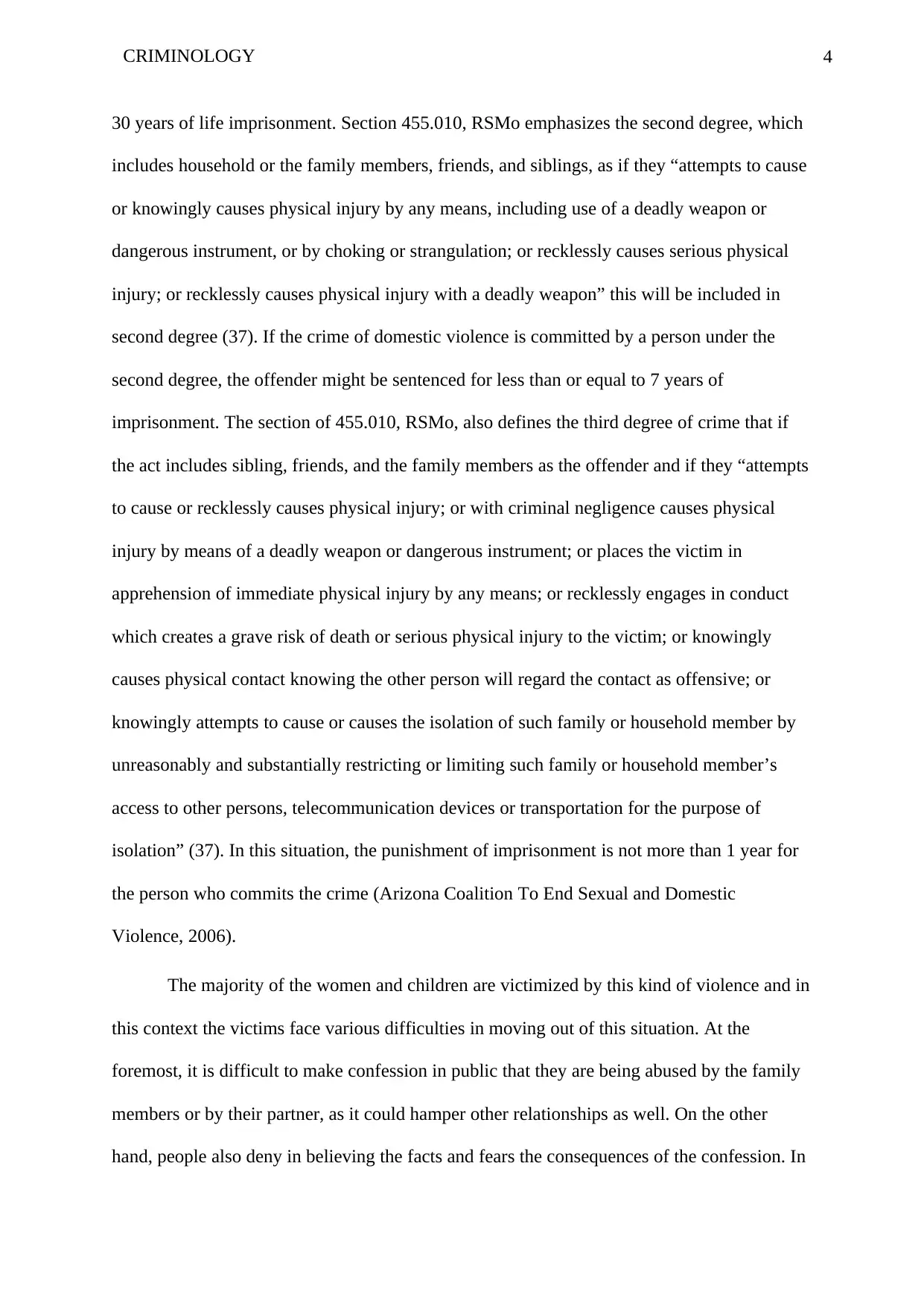
4CRIMINOLOGY
30 years of life imprisonment. Section 455.010, RSMo emphasizes the second degree, which
includes household or the family members, friends, and siblings, as if they “attempts to cause
or knowingly causes physical injury by any means, including use of a deadly weapon or
dangerous instrument, or by choking or strangulation; or recklessly causes serious physical
injury; or recklessly causes physical injury with a deadly weapon” this will be included in
second degree (37). If the crime of domestic violence is committed by a person under the
second degree, the offender might be sentenced for less than or equal to 7 years of
imprisonment. The section of 455.010, RSMo, also defines the third degree of crime that if
the act includes sibling, friends, and the family members as the offender and if they “attempts
to cause or recklessly causes physical injury; or with criminal negligence causes physical
injury by means of a deadly weapon or dangerous instrument; or places the victim in
apprehension of immediate physical injury by any means; or recklessly engages in conduct
which creates a grave risk of death or serious physical injury to the victim; or knowingly
causes physical contact knowing the other person will regard the contact as offensive; or
knowingly attempts to cause or causes the isolation of such family or household member by
unreasonably and substantially restricting or limiting such family or household member’s
access to other persons, telecommunication devices or transportation for the purpose of
isolation” (37). In this situation, the punishment of imprisonment is not more than 1 year for
the person who commits the crime (Arizona Coalition To End Sexual and Domestic
Violence, 2006).
The majority of the women and children are victimized by this kind of violence and in
this context the victims face various difficulties in moving out of this situation. At the
foremost, it is difficult to make confession in public that they are being abused by the family
members or by their partner, as it could hamper other relationships as well. On the other
hand, people also deny in believing the facts and fears the consequences of the confession. In
30 years of life imprisonment. Section 455.010, RSMo emphasizes the second degree, which
includes household or the family members, friends, and siblings, as if they “attempts to cause
or knowingly causes physical injury by any means, including use of a deadly weapon or
dangerous instrument, or by choking or strangulation; or recklessly causes serious physical
injury; or recklessly causes physical injury with a deadly weapon” this will be included in
second degree (37). If the crime of domestic violence is committed by a person under the
second degree, the offender might be sentenced for less than or equal to 7 years of
imprisonment. The section of 455.010, RSMo, also defines the third degree of crime that if
the act includes sibling, friends, and the family members as the offender and if they “attempts
to cause or recklessly causes physical injury; or with criminal negligence causes physical
injury by means of a deadly weapon or dangerous instrument; or places the victim in
apprehension of immediate physical injury by any means; or recklessly engages in conduct
which creates a grave risk of death or serious physical injury to the victim; or knowingly
causes physical contact knowing the other person will regard the contact as offensive; or
knowingly attempts to cause or causes the isolation of such family or household member by
unreasonably and substantially restricting or limiting such family or household member’s
access to other persons, telecommunication devices or transportation for the purpose of
isolation” (37). In this situation, the punishment of imprisonment is not more than 1 year for
the person who commits the crime (Arizona Coalition To End Sexual and Domestic
Violence, 2006).
The majority of the women and children are victimized by this kind of violence and in
this context the victims face various difficulties in moving out of this situation. At the
foremost, it is difficult to make confession in public that they are being abused by the family
members or by their partner, as it could hamper other relationships as well. On the other
hand, people also deny in believing the facts and fears the consequences of the confession. In
Paraphrase This Document
Need a fresh take? Get an instant paraphrase of this document with our AI Paraphraser
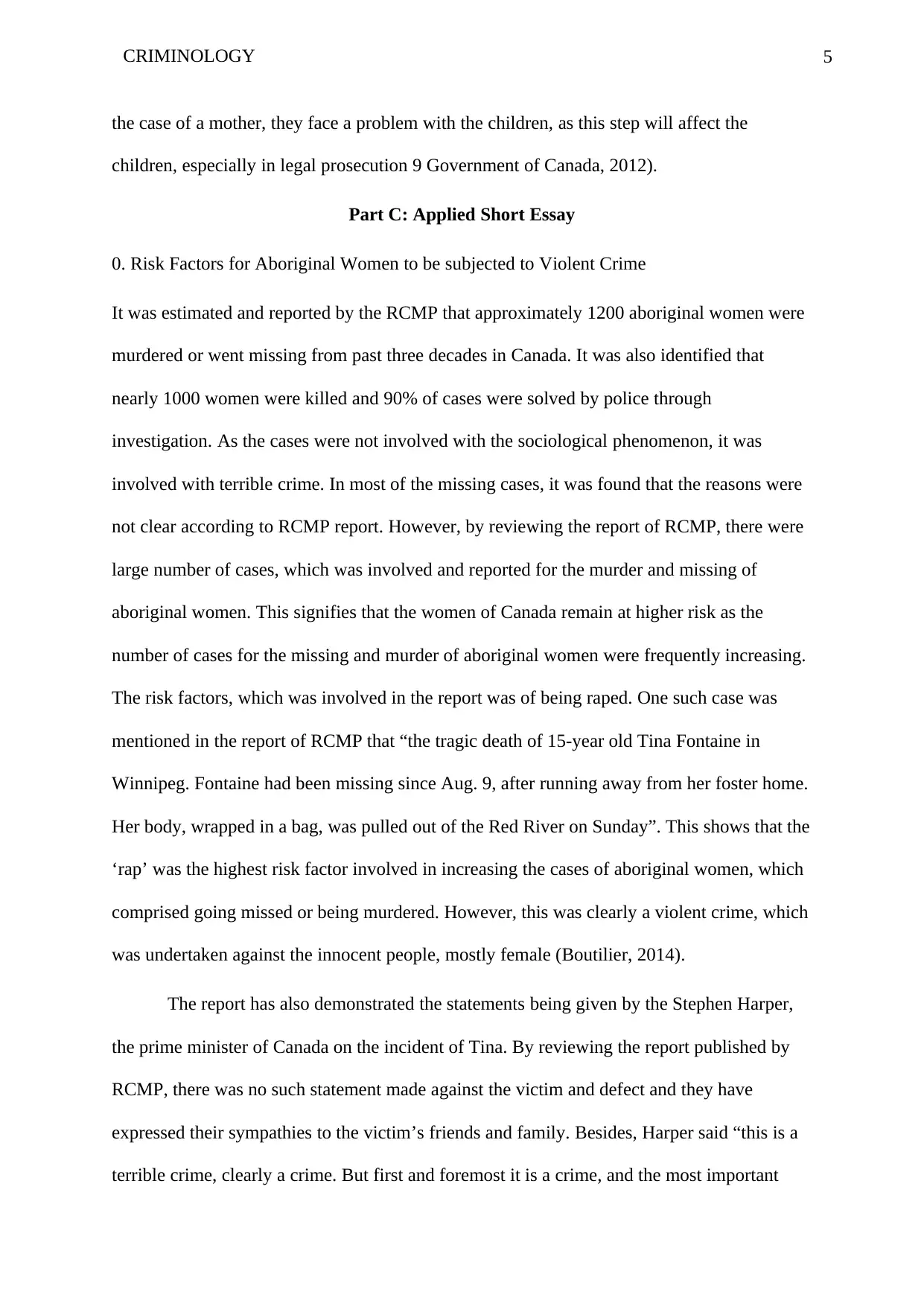
5CRIMINOLOGY
the case of a mother, they face a problem with the children, as this step will affect the
children, especially in legal prosecution 9 Government of Canada, 2012).
Part C: Applied Short Essay
0. Risk Factors for Aboriginal Women to be subjected to Violent Crime
It was estimated and reported by the RCMP that approximately 1200 aboriginal women were
murdered or went missing from past three decades in Canada. It was also identified that
nearly 1000 women were killed and 90% of cases were solved by police through
investigation. As the cases were not involved with the sociological phenomenon, it was
involved with terrible crime. In most of the missing cases, it was found that the reasons were
not clear according to RCMP report. However, by reviewing the report of RCMP, there were
large number of cases, which was involved and reported for the murder and missing of
aboriginal women. This signifies that the women of Canada remain at higher risk as the
number of cases for the missing and murder of aboriginal women were frequently increasing.
The risk factors, which was involved in the report was of being raped. One such case was
mentioned in the report of RCMP that “the tragic death of 15-year old Tina Fontaine in
Winnipeg. Fontaine had been missing since Aug. 9, after running away from her foster home.
Her body, wrapped in a bag, was pulled out of the Red River on Sunday”. This shows that the
‘rap’ was the highest risk factor involved in increasing the cases of aboriginal women, which
comprised going missed or being murdered. However, this was clearly a violent crime, which
was undertaken against the innocent people, mostly female (Boutilier, 2014).
The report has also demonstrated the statements being given by the Stephen Harper,
the prime minister of Canada on the incident of Tina. By reviewing the report published by
RCMP, there was no such statement made against the victim and defect and they have
expressed their sympathies to the victim’s friends and family. Besides, Harper said “this is a
terrible crime, clearly a crime. But first and foremost it is a crime, and the most important
the case of a mother, they face a problem with the children, as this step will affect the
children, especially in legal prosecution 9 Government of Canada, 2012).
Part C: Applied Short Essay
0. Risk Factors for Aboriginal Women to be subjected to Violent Crime
It was estimated and reported by the RCMP that approximately 1200 aboriginal women were
murdered or went missing from past three decades in Canada. It was also identified that
nearly 1000 women were killed and 90% of cases were solved by police through
investigation. As the cases were not involved with the sociological phenomenon, it was
involved with terrible crime. In most of the missing cases, it was found that the reasons were
not clear according to RCMP report. However, by reviewing the report of RCMP, there were
large number of cases, which was involved and reported for the murder and missing of
aboriginal women. This signifies that the women of Canada remain at higher risk as the
number of cases for the missing and murder of aboriginal women were frequently increasing.
The risk factors, which was involved in the report was of being raped. One such case was
mentioned in the report of RCMP that “the tragic death of 15-year old Tina Fontaine in
Winnipeg. Fontaine had been missing since Aug. 9, after running away from her foster home.
Her body, wrapped in a bag, was pulled out of the Red River on Sunday”. This shows that the
‘rap’ was the highest risk factor involved in increasing the cases of aboriginal women, which
comprised going missed or being murdered. However, this was clearly a violent crime, which
was undertaken against the innocent people, mostly female (Boutilier, 2014).
The report has also demonstrated the statements being given by the Stephen Harper,
the prime minister of Canada on the incident of Tina. By reviewing the report published by
RCMP, there was no such statement made against the victim and defect and they have
expressed their sympathies to the victim’s friends and family. Besides, Harper said “this is a
terrible crime, clearly a crime. But first and foremost it is a crime, and the most important
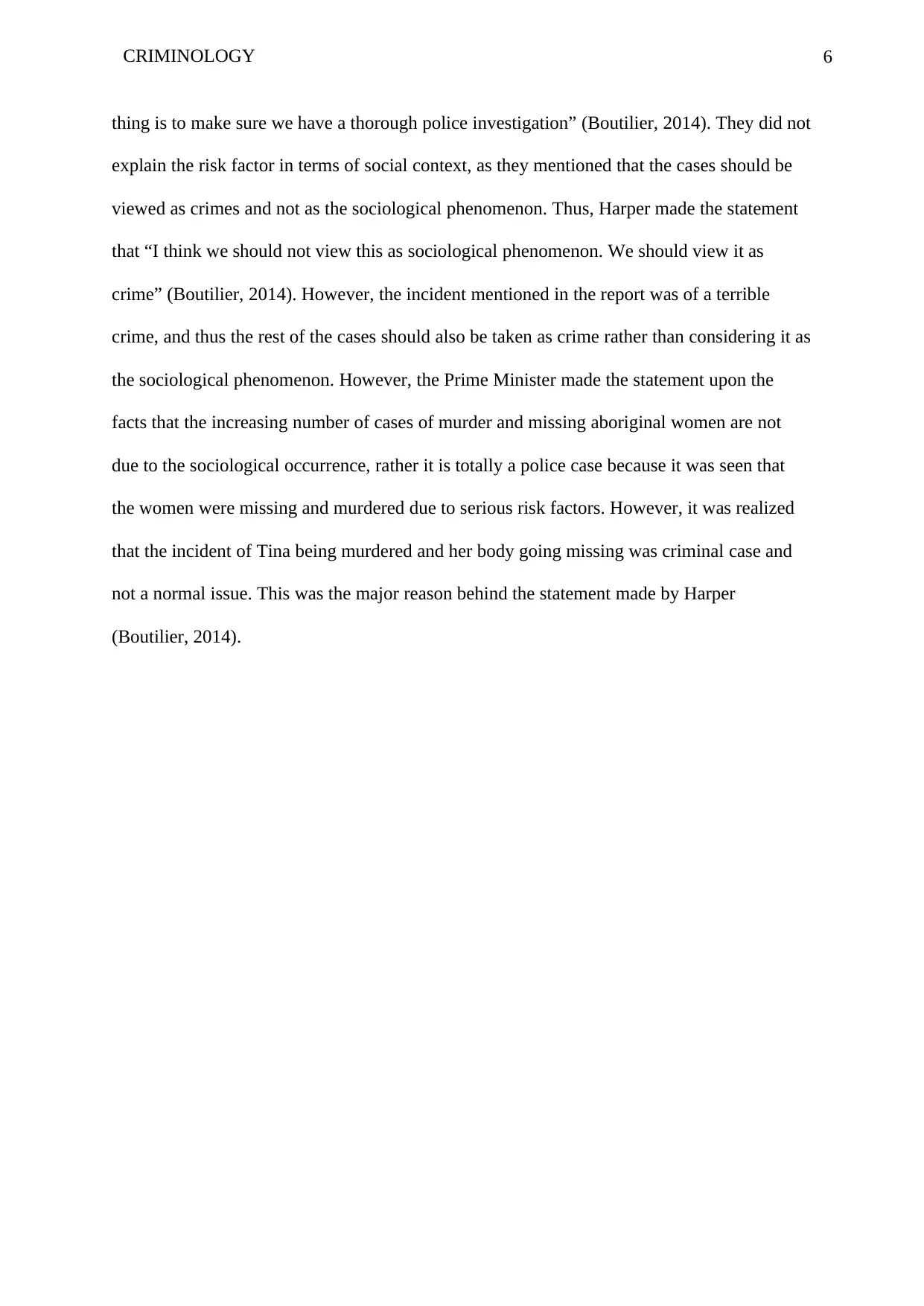
6CRIMINOLOGY
thing is to make sure we have a thorough police investigation” (Boutilier, 2014). They did not
explain the risk factor in terms of social context, as they mentioned that the cases should be
viewed as crimes and not as the sociological phenomenon. Thus, Harper made the statement
that “I think we should not view this as sociological phenomenon. We should view it as
crime” (Boutilier, 2014). However, the incident mentioned in the report was of a terrible
crime, and thus the rest of the cases should also be taken as crime rather than considering it as
the sociological phenomenon. However, the Prime Minister made the statement upon the
facts that the increasing number of cases of murder and missing aboriginal women are not
due to the sociological occurrence, rather it is totally a police case because it was seen that
the women were missing and murdered due to serious risk factors. However, it was realized
that the incident of Tina being murdered and her body going missing was criminal case and
not a normal issue. This was the major reason behind the statement made by Harper
(Boutilier, 2014).
thing is to make sure we have a thorough police investigation” (Boutilier, 2014). They did not
explain the risk factor in terms of social context, as they mentioned that the cases should be
viewed as crimes and not as the sociological phenomenon. Thus, Harper made the statement
that “I think we should not view this as sociological phenomenon. We should view it as
crime” (Boutilier, 2014). However, the incident mentioned in the report was of a terrible
crime, and thus the rest of the cases should also be taken as crime rather than considering it as
the sociological phenomenon. However, the Prime Minister made the statement upon the
facts that the increasing number of cases of murder and missing aboriginal women are not
due to the sociological occurrence, rather it is totally a police case because it was seen that
the women were missing and murdered due to serious risk factors. However, it was realized
that the incident of Tina being murdered and her body going missing was criminal case and
not a normal issue. This was the major reason behind the statement made by Harper
(Boutilier, 2014).
⊘ This is a preview!⊘
Do you want full access?
Subscribe today to unlock all pages.

Trusted by 1+ million students worldwide
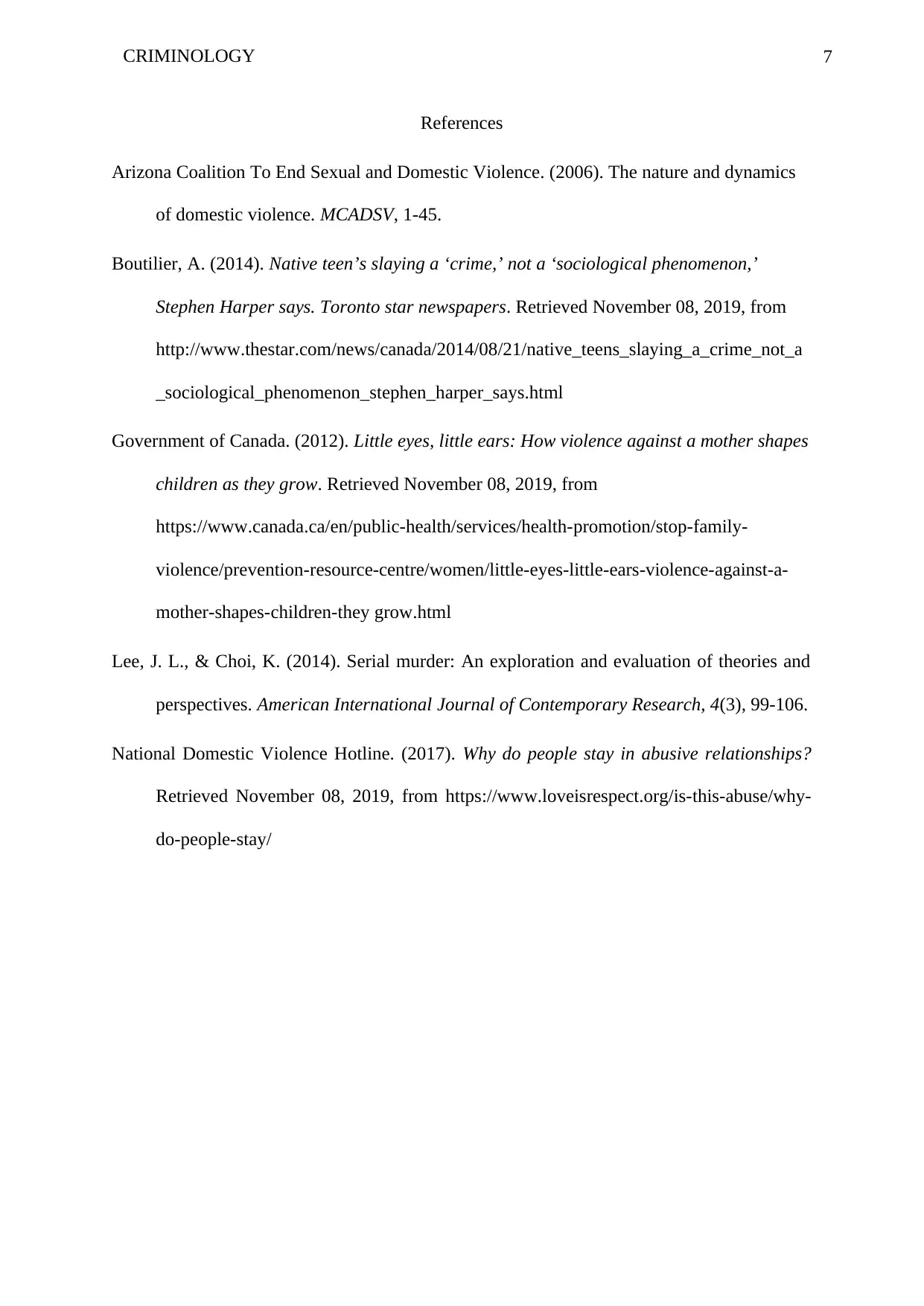
7CRIMINOLOGY
References
Arizona Coalition To End Sexual and Domestic Violence. (2006). The nature and dynamics
of domestic violence. MCADSV, 1-45.
Boutilier, A. (2014). Native teen’s slaying a ‘crime,’ not a ‘sociological phenomenon,’
Stephen Harper says. Toronto star newspapers. Retrieved November 08, 2019, from
http://www.thestar.com/news/canada/2014/08/21/native_teens_slaying_a_crime_not_a
_sociological_phenomenon_stephen_harper_says.html
Government of Canada. (2012). Little eyes, little ears: How violence against a mother shapes
children as they grow. Retrieved November 08, 2019, from
https://www.canada.ca/en/public-health/services/health-promotion/stop-family-
violence/prevention-resource-centre/women/little-eyes-little-ears-violence-against-a-
mother-shapes-children-they grow.html
Lee, J. L., & Choi, K. (2014). Serial murder: An exploration and evaluation of theories and
perspectives. American International Journal of Contemporary Research, 4(3), 99-106.
National Domestic Violence Hotline. (2017). Why do people stay in abusive relationships?
Retrieved November 08, 2019, from https://www.loveisrespect.org/is-this-abuse/why-
do-people-stay/
References
Arizona Coalition To End Sexual and Domestic Violence. (2006). The nature and dynamics
of domestic violence. MCADSV, 1-45.
Boutilier, A. (2014). Native teen’s slaying a ‘crime,’ not a ‘sociological phenomenon,’
Stephen Harper says. Toronto star newspapers. Retrieved November 08, 2019, from
http://www.thestar.com/news/canada/2014/08/21/native_teens_slaying_a_crime_not_a
_sociological_phenomenon_stephen_harper_says.html
Government of Canada. (2012). Little eyes, little ears: How violence against a mother shapes
children as they grow. Retrieved November 08, 2019, from
https://www.canada.ca/en/public-health/services/health-promotion/stop-family-
violence/prevention-resource-centre/women/little-eyes-little-ears-violence-against-a-
mother-shapes-children-they grow.html
Lee, J. L., & Choi, K. (2014). Serial murder: An exploration and evaluation of theories and
perspectives. American International Journal of Contemporary Research, 4(3), 99-106.
National Domestic Violence Hotline. (2017). Why do people stay in abusive relationships?
Retrieved November 08, 2019, from https://www.loveisrespect.org/is-this-abuse/why-
do-people-stay/
1 out of 7
Related Documents
Your All-in-One AI-Powered Toolkit for Academic Success.
+13062052269
info@desklib.com
Available 24*7 on WhatsApp / Email
![[object Object]](/_next/static/media/star-bottom.7253800d.svg)
Unlock your academic potential
Copyright © 2020–2025 A2Z Services. All Rights Reserved. Developed and managed by ZUCOL.





